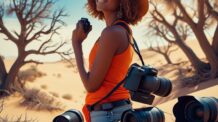Exposure is the foundation of photography. It’s the balance of light that determines how bright or dark your photo appears. Understanding exposure gives you control over your images, allowing you to capture what you see — or create something entirely new with light.
In this guide, you’ll learn what exposure really means, how it works, and how to master it using the three core elements: aperture, shutter speed, and ISO — also known as the exposure triangle.
What Is Exposure in Photography?
In simple terms, exposure is the amount of light that reaches your camera’s sensor. Too much light, and your photo is overexposed (too bright, with lost highlights). Too little light, and it’s underexposed (too dark, with lost shadow detail).
A correctly exposed photo captures all the details you want in both the bright and dark areas.
You control exposure by adjusting three camera settings:
- Aperture
- Shutter Speed
- ISO
These three settings work together to form the exposure triangle.
The Exposure Triangle Explained
1. Aperture (f-stop)
The aperture is the opening inside your lens that controls how much light enters the camera. It also affects depth of field — how much of the image is in focus from front to back.
- A wide aperture (e.g., f/1.8, f/2.8) lets in more light and creates a shallow depth of field (blurred background).
- A narrow aperture (e.g., f/8, f/11, f/16) lets in less light and creates a deep depth of field (more of the image in focus).
Aperture tips:
- Use a wide aperture for portraits (soft background).
- Use a narrow aperture for landscapes (everything sharp).
2. Shutter Speed
Shutter speed controls how long the camera’s shutter stays open to let light hit the sensor. It also determines how motion is captured.
- A fast shutter speed (e.g., 1/1000s, 1/500s) freezes motion.
- A slow shutter speed (e.g., 1/30s, 1″, 5″) captures motion blur or light trails.
Shutter speed tips:
- Use fast speeds for sports, wildlife, and handheld shooting.
- Use slow speeds for long exposures (night shots, waterfalls) with a tripod.
3. ISO
ISO measures your camera sensor’s sensitivity to light.
- A low ISO (100–400) produces cleaner images with less noise.
- A high ISO (800–3200 or more) helps in low light but can add grain or noise to your images.
ISO tips:
- Always use the lowest ISO possible for your lighting conditions.
- Increase ISO when you need more light and can’t slow the shutter or open the aperture.
How to Get a Correct Exposure
Use manual mode (M) or semi-automatic modes like:
- Aperture Priority (A or Av) — you choose aperture, camera sets shutter speed
- Shutter Priority (S or Tv) — you choose shutter speed, camera sets aperture
Use your camera’s exposure meter (usually a scale from -3 to +3) to guide you. Aim for a balanced exposure (close to 0), but feel free to adjust for creative effect.
Exposure Scenarios
Portrait in Natural Light
- Aperture: f/2.8 (blurred background)
- Shutter speed: 1/250s
- ISO: 100–400
Landscape in Daylight
- Aperture: f/11 (sharp throughout)
- Shutter speed: 1/125s
- ISO: 100
Low Light Indoors (No Flash)
- Aperture: f/1.8
- Shutter speed: 1/60s
- ISO: 800–1600
Long Exposure at Night
- Aperture: f/8
- Shutter speed: 10–30 seconds
- ISO: 100
- Use a tripod to avoid blur
Using Exposure Compensation
If you’re using auto or semi-auto modes and your images are too dark or too bright, use exposure compensation (+/- button) to adjust.
- +1 or +2 = brightens the image
- –1 or –2 = darkens the image
This is helpful when your camera is fooled by tricky lighting, like backlit subjects or snow.
Practice Exercises
- Take the same photo with different apertures and observe the depth of field.
- Photograph moving subjects with varying shutter speeds.
- Try shooting the same scene at different ISO levels and compare the noise.
- Use manual mode and experiment with balancing all three settings.
- Shoot in RAW format so you can fine-tune exposure in post-processing.
Final Thoughts
Exposure is the heartbeat of photography. Once you understand how aperture, shutter speed, and ISO work together, you gain full creative control over your images. You’ll be able to adapt to any lighting situation, avoid blurry or blown-out shots, and express your vision with precision.
Mastering exposure takes time and practice — but it’s the first big step toward becoming a confident, capable photographer.




Deixe um comentário